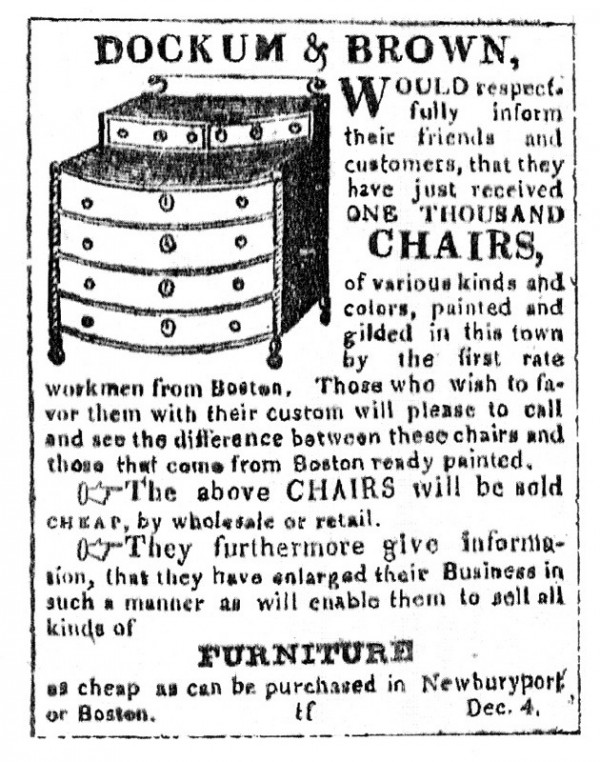
Advertisement of Samuel M. Dockum and Edmund M. Brown. (New-Hampshire Gazette [Portsmouth], December 11, 1827.)
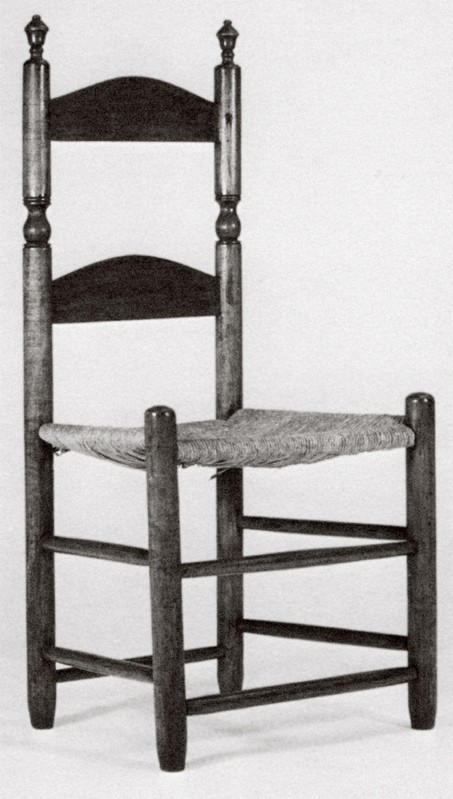
Slat-back side chair attributed to John Durand (1735–1780) or Samuel Durand I (1738–1829), Milford, Connecticut, 1760–1770. Maple, ash, and poplar; rush. H. 37 5/8", W. 18 7/8", D. 13 1/2. (Courtesy, Stratford Historical Society, Stratford, Connecticut, gift of Miss Martha Miles.) Surface finish not original.
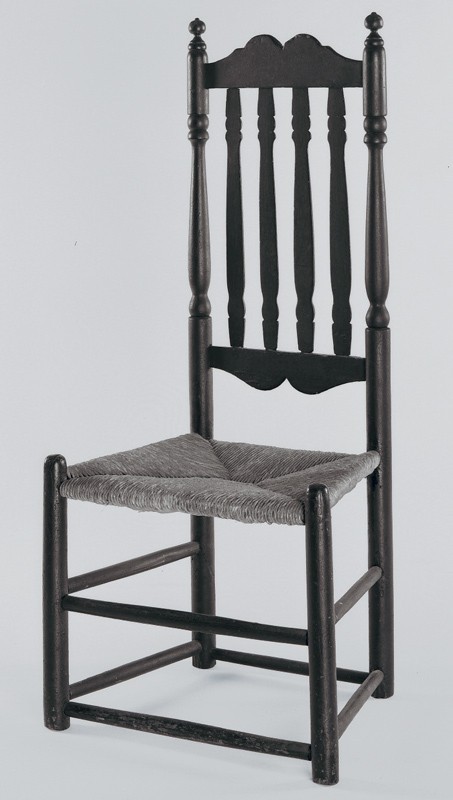
Banister-back side chair, Portsmouth, New Hampshire, area 1760–1800. Maple and ash; rush. H. 40 3/4", W. 19", D. 13 1/4". (Courtesy, Historic New England, Boston, Massachusetts, gift of Joseph W. Hobbs; photo, David Bohl.) Surface paint not original.

Fiddle-back side chair possibly made by John Durand or Samuel Durand I, probably Milford, Connecticut, 1760–1800. Maple; rush. H. 40 3/16", W. 18 1/8", D. 15 1/4". (Courtesy, Winterthur Museum, Winterthur, Delaware.) Black surface paint over a red primer; possibly original.
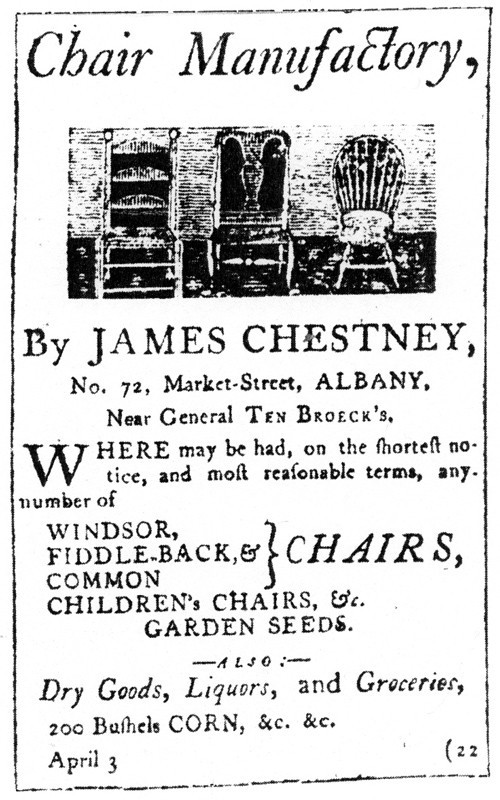
Advertisement of James Chestney. (Albany Chronicle [New York], April 10, 1797.)
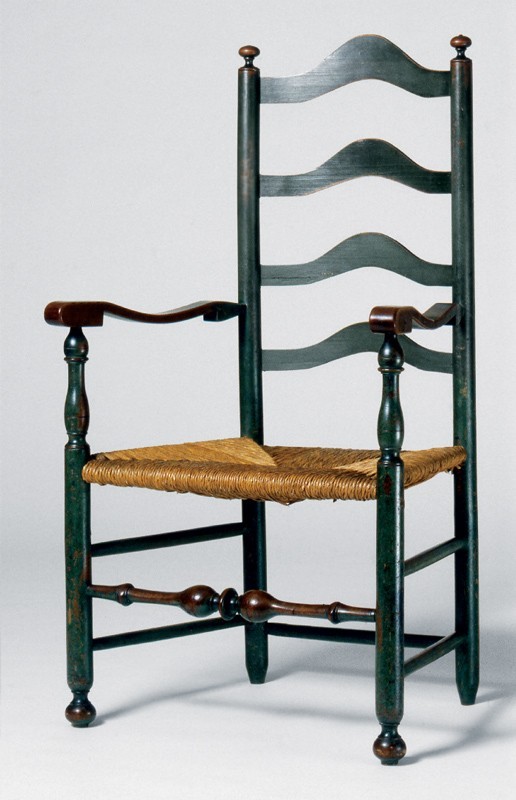
Slat-back armchair, Delaware Valley, 1750–1775. Maple and hickory; rush. H. 43", W. 24 7/8", D. 20 1/2". (Courtesy, Winterthur Museum.) Surface paint not original.
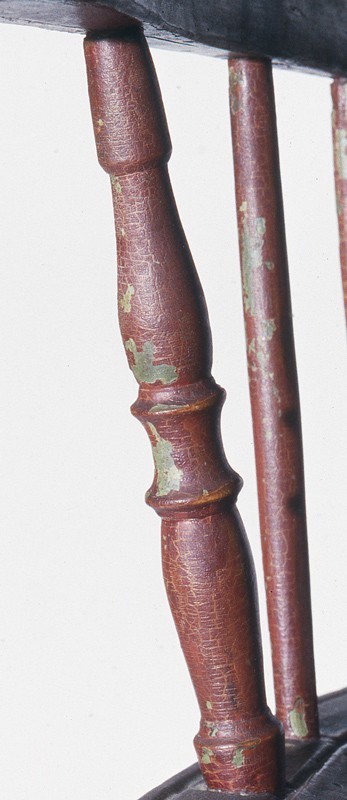
Detail, left arm post of sack-back Windsor armchair, Rhode Island, 1780–1800. White pine (seat) with maple, oak, hickory, and ash. H. 39 9/16", W. 23", D. 16 1/4". (Courtesy, Winterthur Museum.) An alligatored surface comprising multiple chipped layers of paint and resin. The “Windsor” green visible in chipped areas is the second coat of paint and probably predates 1815. This is the ubiquitous green made from the pigment verdigris, the color dulled owing to deterioration and yellowing of the protective resin coat.

Tall, braced fan-back Windsor armchair branded by Charles Chase (1731–1815), Nantucket, Massachusetts, 1790–1805. White pine (seat) with ash, birch, and oak. H. 42 3/4", W. 27 3/8", D. 20". (Courtesy, Winterthur Museum.) Present surface black; original surface verdigris green.

Shaped-tablet-top Windsor side chair with splat, branded by John Swint (act. ca. 1847 and later; chair one of four), Lancaster, Pennsylvania, 1847–1855. Yellow poplar (seat). H. 33", W. 18 3/8", D. 14 5/8". (Courtesy, Lancaster.History .org, Lancaster, Pennsylvania; photo, Winterthur Museum.) Original decoration and surface paint approximating the olive green current by the second quarter of the nineteenth century.
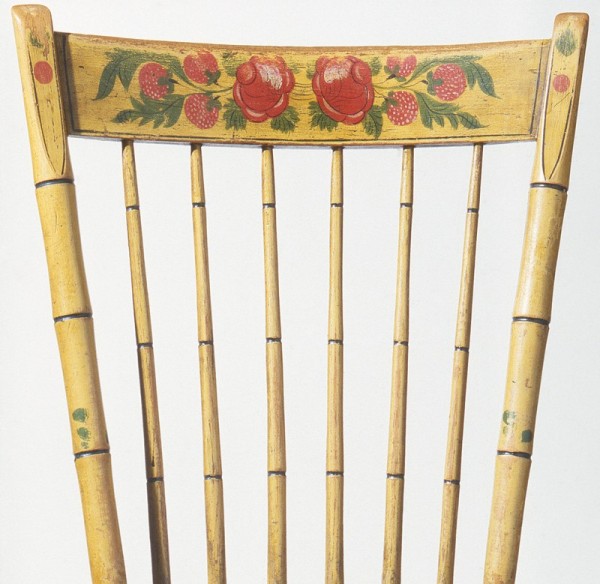
Detail, slat-back Windsor side chair, southeastern central Pennsylvania, 1820–1830. Yellow poplar (seat) with maple. H. 35", W. 17 1/2", D. 15 5/8". (Courtesy, Winterthur Museum.) Original decoration and surface paint in bright yellow, the formula either the patent yellow or chrome yellow current in the early nineteenth century.
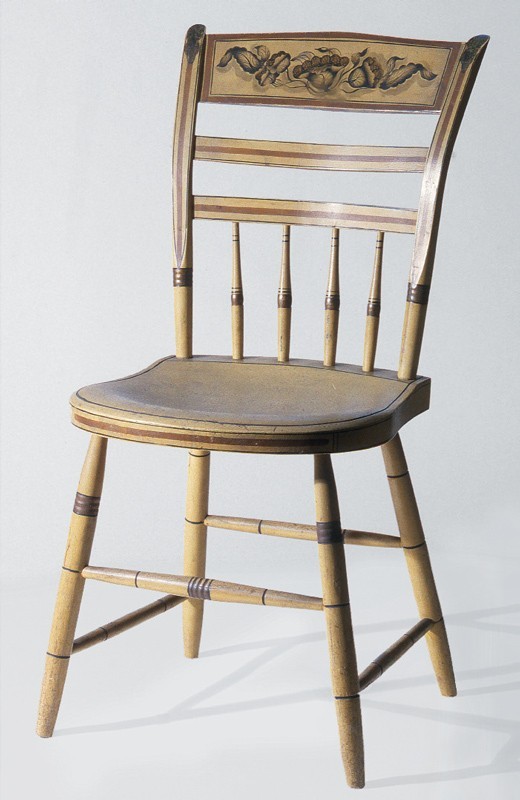
Slat-back (or triple-back) Windsor side chair branded by Silas Buss (chair one of four), Sterling, Massachusetts, 1820–1830. White pine (seat). H. 34 7/8", W. 16 1/2", D. 15 3/4". (Courtesy, Marblehead Museum and Historical Society, Marblehead, Massachusetts; photo, Winterthur Museum.) Original decoration and surface paint in pale yellow termed either “straw” or “cane” color in the early nineteenth century.
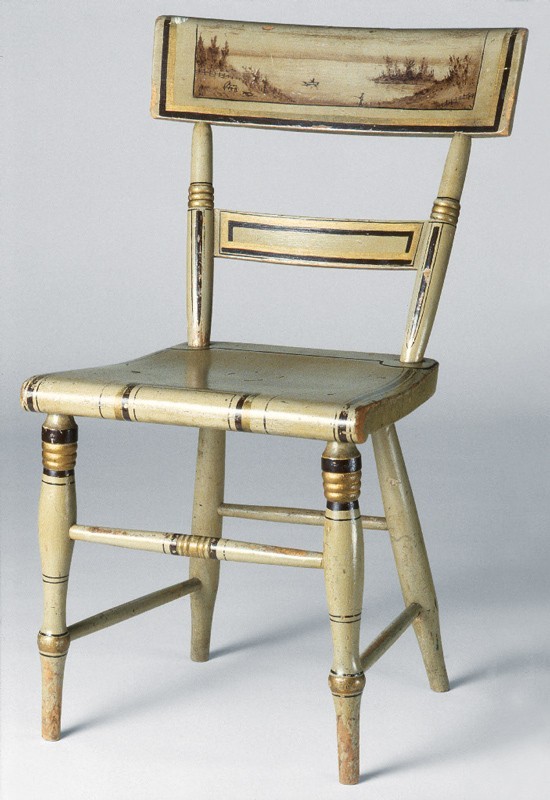
Tablet-top Windsor side chair with stenciled identification of Cornelius E. R. Davis (one of six with a settee), Carlisle, Pennsylvania, ca. 1831–1835. Yellow poplar (seat). H. 32 7/8", W. 19 1/4", D. 15 1/8". (Courtesy, Cumberland County Historical Society, Carlisle, Pennsylvania; photo, Winterthur Museum.) Original decoration and surface paint in cream yellow.

Slat-back (or fret-back) fancy side chair, New York City or possibly central Connecticut, 1810–1820. Woods unknown; rush. Dimensions unknown. (Present location unknown; formerly in an institutional collection; photo, Winterthur Museum.) Original decoration and surface paint in white yellowed by a resin finish. A side chair of identical structure but different decoration has a nineteenth-century history in the Day family of Hartford, Connecticut.
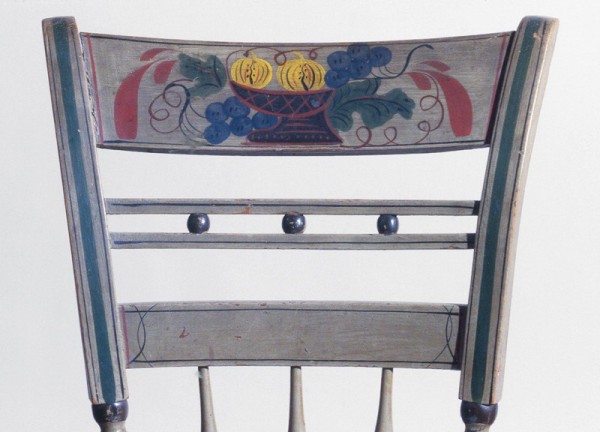
Detail, slat-back (or ball-back) Windsor side chair, Hudson River valley, ca. 1820–1828. Yellow poplar (seat). H. 33 9/16", W. 16 1/4", D. 15". (Courtesy, Fenimore Art Museum, Cooperstown, New York; photo, Winterthur Museum N0025.1954.) Original decoration and surface paint in medium gray.

Slat-back fancy side chair with “Cumberland spindles,” New York City or environs, 1810–1820. Maple, birch, and yellow poplar; rush. H. 35", W. 19", D. 15 3/4". (Courtesy, Winterthur Museum.) Original decoration and surface paint in black.
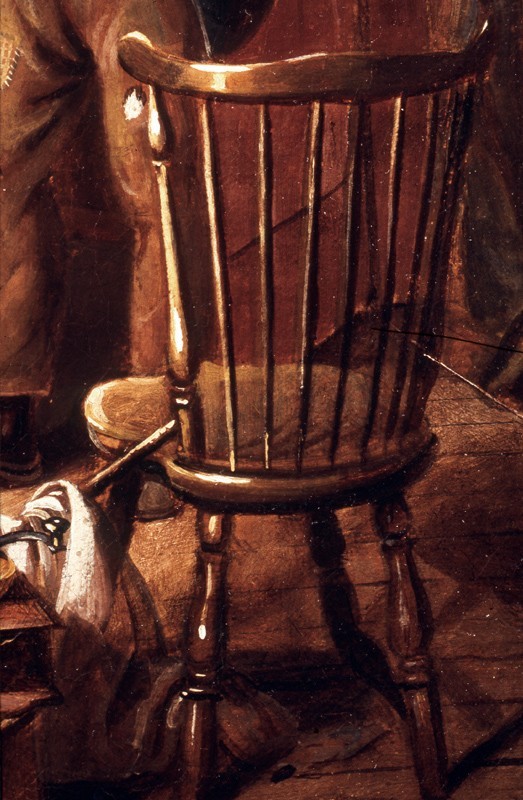
Detail, Philadelphia fan-back Windsor side chair painted mahogany color, from John Lewis Krimmel, Quilting Frolic, Philadelphia, Pennsylvania, 1813. Oil on canvas. 16 7/8" x 22 3/8". (Courtesy, Winterthur Museum.)
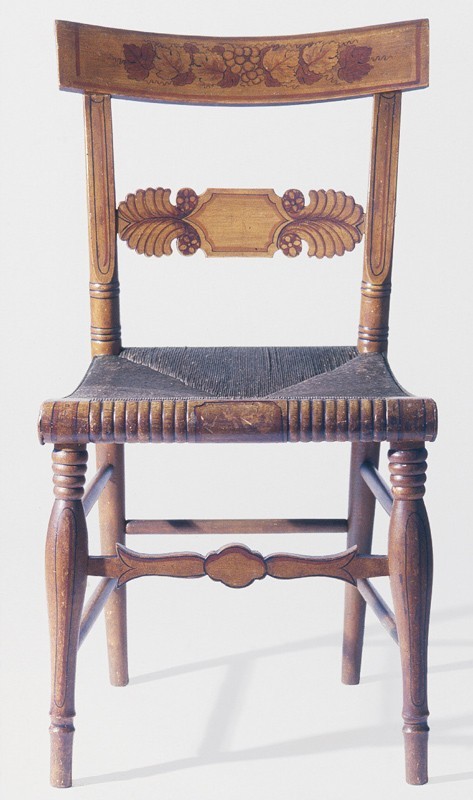
Tablet-top (or fret-back) fancy side chair, southeastern Pennsylvania or Maryland, 1825–1835. Woods unknown; rush. Dimensions unknown. (Present location unknown; formerly in an institutional collection; photo, Winterthur Museum.) Original decoration and surface paint in light stone color (drab).

Detail, slat-back Windsor rocking armchair with “flat sticks” (spindles), southern New Hampshire, 1820–1830. Maple and unidentified woods. H. 31", W. 19 3/8", D. 16 5/8" (seat). (Present location unknown; formerly in a private collection; photo, Winterthur Museum.) Original decoration and surface paint in coquelicot red.

Tablet-top single-cross-back fancy side chair (one of five), Baltimore, Maryland, 1805–1815. Maple, butternut, and black walnut; cane. H. 32 1/2", W. 19", D. 16". (Courtesy, Winterthur Museum.) Original decoration and surface paint in coquelicot red.
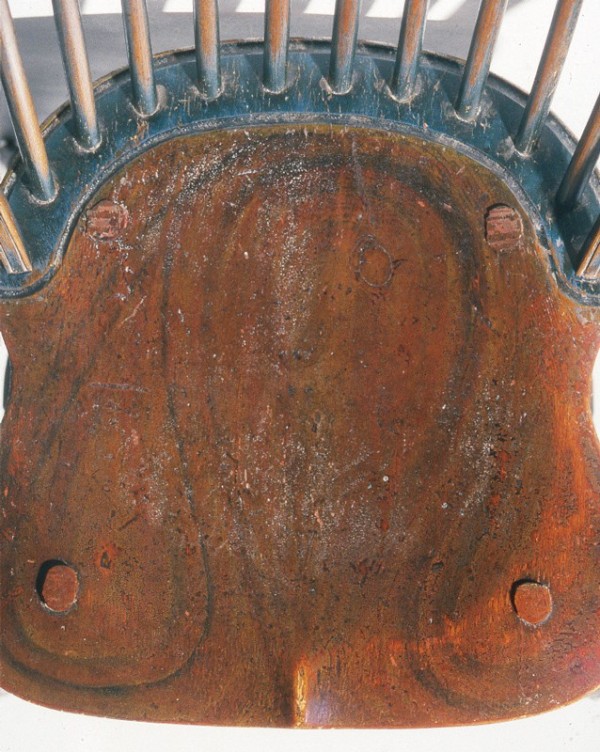
Detail, bow-back Windsor side chair (one of six), Connecticut–Rhode Island border region, ca. 1797–1805. White pine (seat) with birch and ash. H. 38", W. 16 3/4", D. 16 3/16". (Courtesy, Winterthur Museum.) Original surface paint in Prussian blue on turned work, spindles, bow, and spindle platform; original “grained” paint on seat top in Venetian red and medium-light umber, with glazes of red and brown forming a looping pattern.
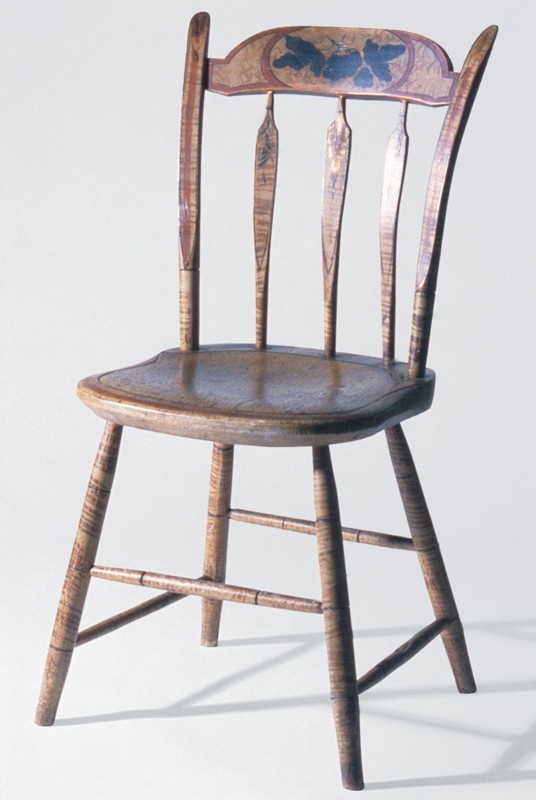
Shaped-slat-back Windsor side chair with flat sticks, northern Worcester County, Massachusetts, 1820–1830. White pine (seat). H. 34 1/8", W. 17 3/8", D. 15 1/4". (Present location unknown; formerly in an institutional collection; photo, Winterthur Museum.) Original decoration and surface paint in grained maple exhibiting a bird’s-eye figure on the crest and a striped figure on the turnings and spindles.
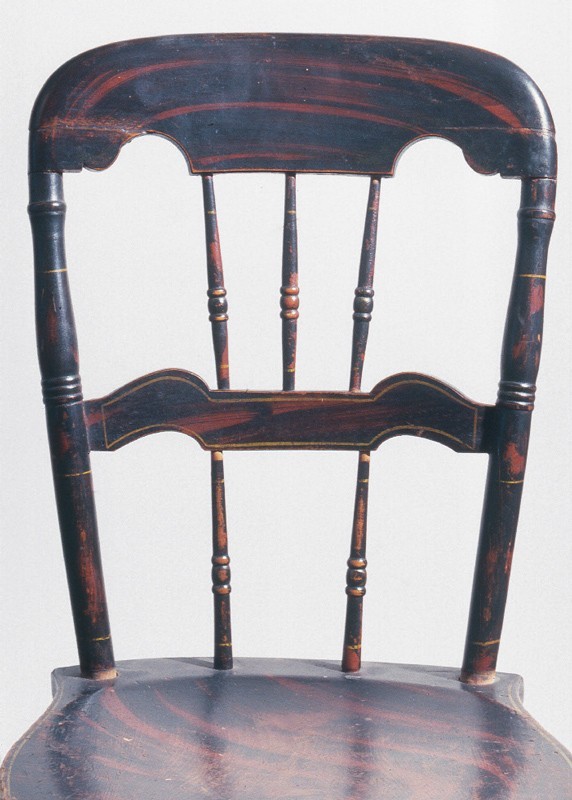
Detail, shaped-tablet-top Windsor side chair with stenciled identification of George Washington Bentley (b. ca. 1814; chair one of four), West Edmeston, New York, 1850–1860. Basswood (seat). H. 34 5/8", W. 15", D. 15". (Courtesy, Fenimore Art Museum, Cooperstown, New York; photo, Winterthur Museum N0256.1959.) Original pinstriping and surface paint in grained rosewood exhibiting a “streaked” figure on the seat, crest, and mid-back slat and a daubed figure on the turnings.

Shaped-tablet-top Windsor side chair with splat and scroll seat, Baltimore, Maryland, or adjacent southern Pennsylvania, 1840–1850. Woods unknown. H. 33 1/4". (Courtesy, Abby Aldrich Rockefeller Folk Art Museum, The Colonial Williamsburg Foundation, Williamsburg, Virginia.) Original decoration and surface paint in mahogany graining.
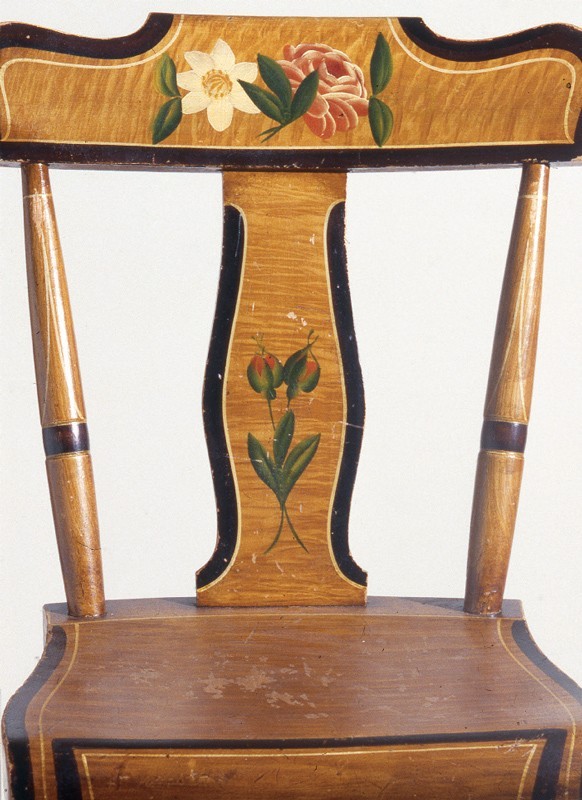
Detail, shaped-tablet-top Windsor side chair with splat (one of six), Pennsylvania, 1850–1870. Yellow poplar (seat). H. 32 1/4", W. 18 1/4", D. 14 1/2". (Present location unknown; formerly in a private collection; photo, Winterthur Museum.) Original decoration and surface paint, probably in satinwood graining.
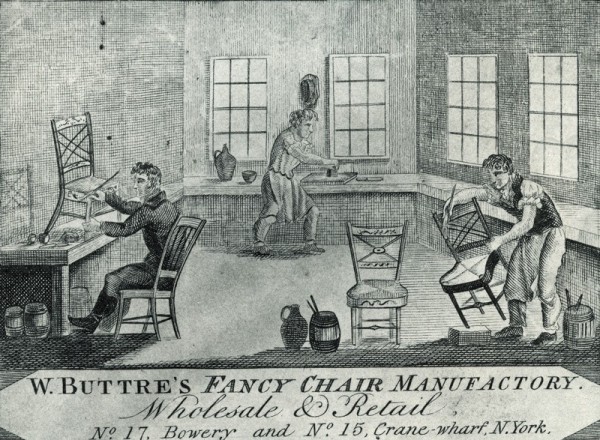
Detail, trade card of William Buttre (1782–1864), New York City, ca. 1813. Engraving. 5 7/8" x 4 1/4". (Courtesy, Winterthur Museum Library, Joseph Downs Collection of Manuscripts and Printed Ephemera.) The scene is a painting room such as that found in a large manufactory producing painted vernacular seating furniture. Note the abundance of windows to admit natural light to the workplace.

Slat-back (or ball-back) Windsor side chair with “organ spindles,” New York City, 1810–1815. Yellow poplar (seat) with maple. H. 32 5/8", W. 17 7/8", D. 15". (Courtesy, Winterthur Museum.) Original decoration and surface paint in pale blue.
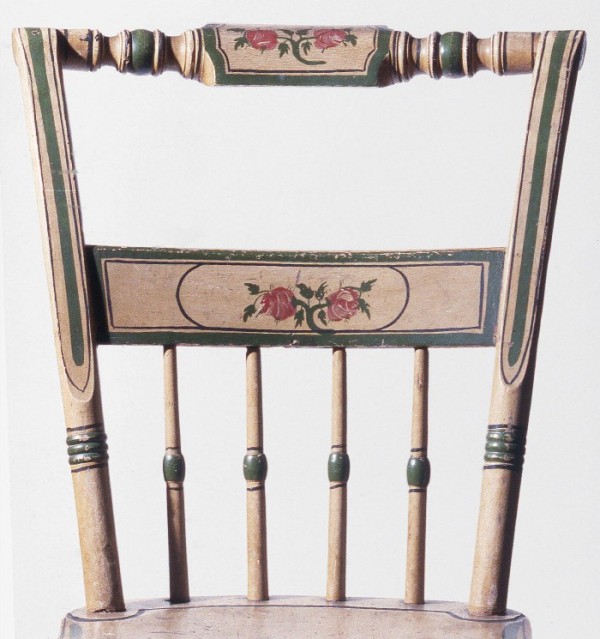
Detail, roll-top Windsor side chair, Philadelphia or eastern Pennsylvania, 1830–1840. Yellow poplar (seat). H. 34 7/8", W. 17 3/8", D. 15 5/16". (Present location unknown; formerly in a private collection; photo, Winterthur Museum.) Original decoration and surface paint in creamy white.

Shaped-tablet-top Windsor side chair with pierced splat and stenciled identification of George Nees (act. 1850 and later), Manheim, Pennsylvania, 1850–1860. Yellow poplar (seat). H. 32 1/4", W. 19 1/2", D. 14 1/4". (Collection of Dr. and Mrs. Donald M. Herr; photo, Winterthur Museum.) Original decoration and surface paint in bright green.
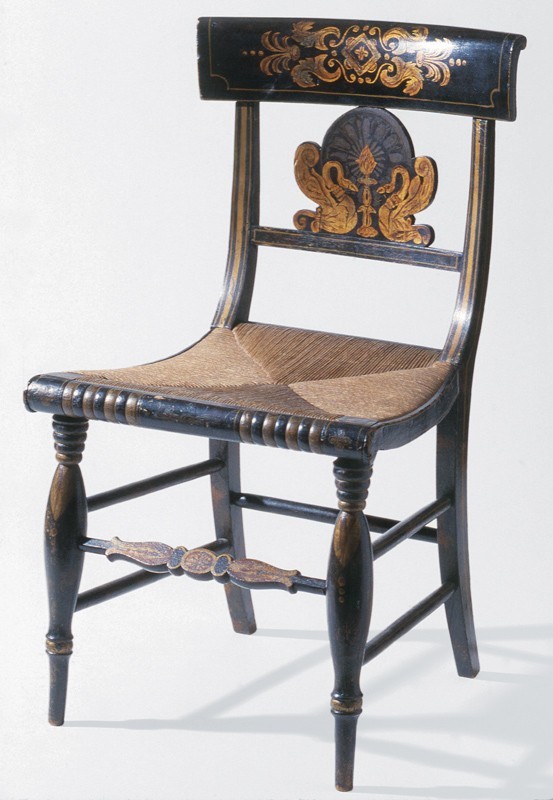
Tablet-top fancy side chair, Baltimore, Maryland, 1820–1830. Woods unknown; rush. H. 33 1/2", W. 18 1/2", D. 15 7/8". (Courtesy, Fenimore Art Museum, gift of Stephen C. Clark, Sr.; photo, Winterthur Museum N0372.1955.) Original decoration and surface paint in dark rosewood graining. The paired-swan motif of the chair back was copied from an ornament in plate 21 of Thomas Hope’s Household Furniture and Interior Decoration (London, 1807).
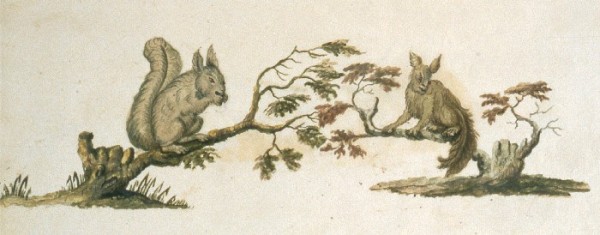
Ornamental design with squirrels from page 12 of a drawing or copy book kept by Christian M. Nestell (1793–1880), when a student at an unknown school in New York City, 1811–1812. Pencil and watercolor on laid paper. (Courtesy, Winterthur Library, Joseph Downs Collection of Manuscripts and Printed Ephemera.)
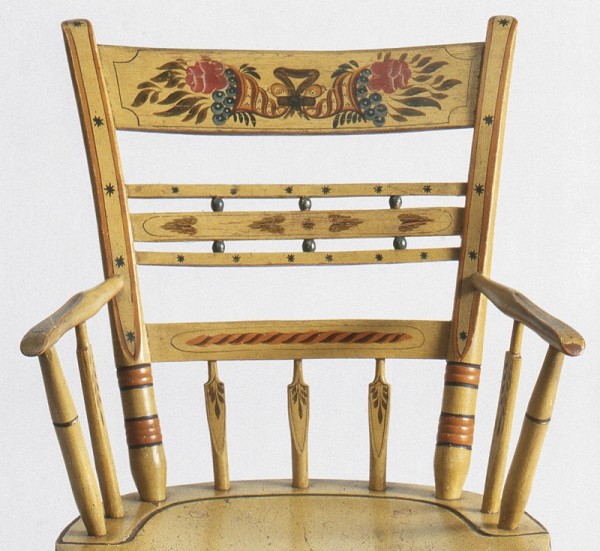
Detail, slat-back (or ball-back) Windsor armchair (one of two), New York City, 1814–1820. Yellow poplar (seat) with maple. H. 34 1/2", W. 19 1/4", D. 16 7/8". (Courtesy, Winterthur Museum.) Original decoration and surface paint in yellow.

Ornamental design with feathers from page 79 of the Nestell drawing or copy book. (Courtesy, Winterthur Library, Joseph Downs Collection of Manuscripts and Printed Ephemera.)

Detail, slat-back (or fret-back) fancy side chair, New York City, 1815–1825. Woods unknown; cane. Dimensions unknown. (Present location unknown; formerly in an institutional collection; photo, Winterthur Museum.) Original decoration and surface paint in light stone color (drab). The transfer-printed profile of Benjamin Franklin is based on a terracotta medallion cast in France in 1777 by Giovanni Battista Nini.

Printed and inscribed bill from William Buttre of New York City to Oliver Wolcott of Connecticut, December 8, 1810, for a large set of fancy chairs ornamented in gold. (Courtesy, The Connecticut Historical Society, Hartford.) The text of the billhead enumerates a selection of chair colors and seating forms.

Shaped-slat-back Windsor rocking armchair, southern New Hampshire, 1820–1830. White pine (seat). H. 35", W. 20 1/4", D. 17 7/8" (seat). (Present location unknown; formerly in a private collection; photo, Winterthur Museum.) Original decoration and surface paint in light stone color (drab).
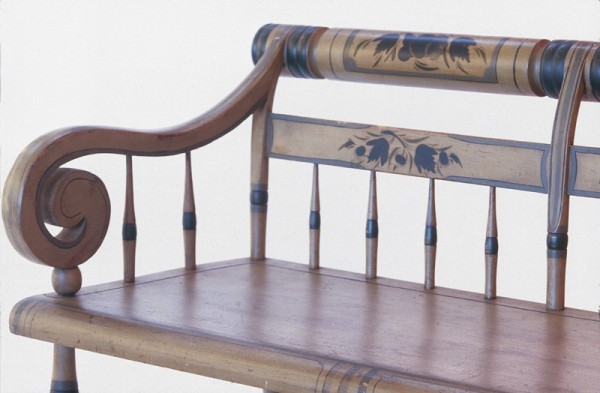
Detail, roll-top Windsor settee with scroll arms, south-central Pennsylvania, 1835–1845. Woods unknown. H. 33 1/8", W. 76 1/2", D. 21". (Present location unknown; formerly in a private collection; photo, Winterthur Museum.) Original decoration and surface paint in light stone color (drab).
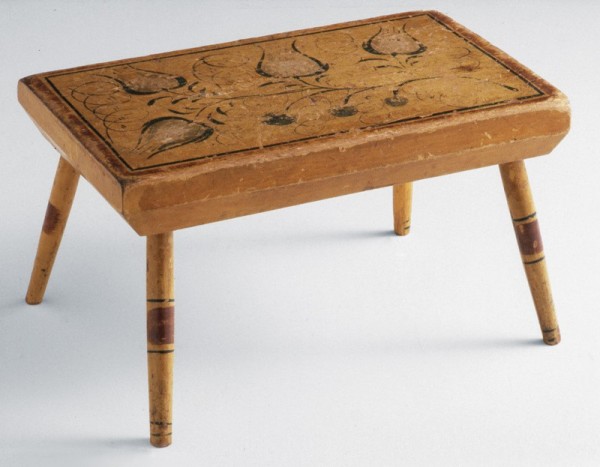
Windsor cricket, or low stool, northern New England, 1825–1840. Basswood (top) with birch. H. 7 1/8", W. 13", D. 8". (Courtesy, Winterthur Museum.) Original decoration and surface paint in yellow.
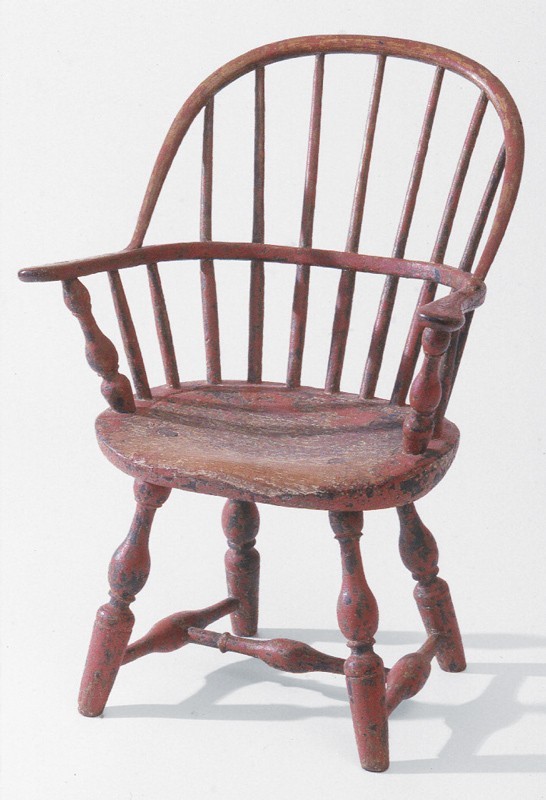
Child’s sack-back Windsor armchair, New York City, 1785–1795. Yellow poplar (seat) with maple and oak. H. 25", W. 18", D. 11 3/8". (Courtesy, Winterthur Museum.) A multilayered surface with coral red on the outside over white over a deteriorated dark color. Given the date and origin of this chair, the original surface paint probably was verdigris green. As demonstrated here, in the absence of an exposed original surface or the presence of a surface cleaned to the bare wood, a surface that retains many layers of paint (and resin) reflecting various surface renewals over time is typical.
